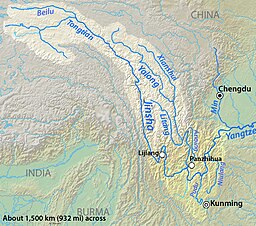Jinsha River
| Jinsha (金沙江) | |
| Yangtze (长江) | |
| River | |
|
Jinsha flowing along the bottom of Tiger Leaping Gorge
|
|
| Name origin: Chinese: "Gold Dust River" | |
| Country | China |
|---|---|
| States | Qinghai, Tibet, Yunnan, Sichuan |
| Part of | Yangtze River basin |
| Tributaries | |
| - left | Beilu River, Yalong River |
| - right | Pudu River, Xiaojiang River, Niulan River |
| Cities | Lijiang, Yunnan, Panzhihua |
| Source | Tongtian River |
| - location | Confluence of the Tongtian and Batang Rivers, Qinghai |
| - elevation | 4,500 m (14,764 ft) |
| - coordinates | 34°05′51″N 92°54′38″E / 34.09750°N 92.91056°E |
| Mouth | Yangtze River |
| - location | Confluence with Min Jiang at Yibin, Sichuan |
| - elevation | 300 m (984 ft) |
| - coordinates | 28°46′05″N 104°38′29″E / 28.76806°N 104.64139°ECoordinates: 28°46′05″N 104°38′29″E / 28.76806°N 104.64139°E |
| Length | 2,290 km (1,423 mi) approx. |
| Basin | 485,000 km2 (187,260 sq mi) approx. |
| Discharge | |
| - average | 4,471 m3/s (157,892 cu ft/s) |
| - max | 35,000 m3/s (1,236,013 cu ft/s) |
|
Map of the Jinsha River drainage basin
|
|
The Jinsha River (Chinese: , p Jīnshājiāng, "Gold Dust River") is the Chinese name for the upper stretches of the Yangtze River. It flows through the provinces of Qinghai, Sichuan, and Yunnan in western China. The river passes through Tiger Leaping Gorge.
It is sometimes grouped together with the Lancang (upper Mekong) and Nu (upper Salween) as the Sanjiang ("Three Rivers") area, part of which makes up the Three Parallel Rivers of Yunnan Protected Areas.
The river was first recorded as the Hei (黑水, Hēishuǐ, lit. "Blackwater") in the Warring States' "Tribute of Yu". It was described as the Sheng (t 繩水, s 绳水, Shéngshuǐ, "Rope River") in the Han-era Classic of Mountains and Seas. During the Three Kingdoms, it was known as the Lu (t 瀘水, s 泸水, Lúshuǐ). The present name was adopted in during the Song dynasty.
...
Wikipedia


